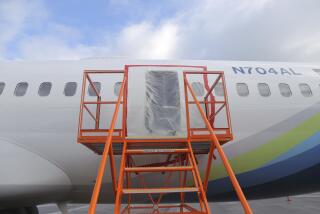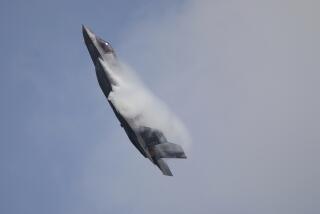U.S. Officials Seeking Cause of Fatal Crash
IRVINE — Investigators trying to determine the cause of Saturday’s fatal jet crash here recovered the plane’s boarding ladder Sunday, which the pilot had complained about moments before the jet went down.
Richard Parker, an investigator with the National Transportation Safety Board, carried the red ladder away from the crash site as salvage crews removed the remains of the French-built four-seat jet from the office building where it crashed.
“It is a point of interest,” Parker said of the ladder.
The plane dropped out of the sky and plunged through the roof of a building owned by Baxter Healthcare Corp. The three people inside the plane died.
Shortly after takeoff Saturday afternoon, the pilot radioed the control tower at John Wayne Airport for permission to return and said the stair-ladder on the plane was loose.
Investigators said the ladder had been hung just behind the cockpit, directly in front of the intake opening in one of the plane’s two engines. Asked if he thought part of the ladder might have entered the intake, Parker said it was unlikely.
“It’s possible, but I don’t think so,” he said.
Parker said that stair-ladders have been known to bang around and distract pilots and thereby cause accidents. But Parker stressed that he had not yet determined a cause of the crash and said he would examine every potential factor.
Parker said he would examine the pilot’s flight record, the plane’s mechanical record, transcripts of communications between the pilot and the tower, and anything that might have been near the plane at the time of the accident.
The three people who died in the crash were identified as David R. Hughes, 57, of Cypress; Tina Schroder, 37, of Newport Beach; and Air Force Sgt. David Brooks Covell, 48, stationed at Vandenberg Air Force Base in Santa Barbara County.
Investigators said they weren’t yet sure who was piloting the plane at the time of the crash, though Parker said he thought it was Covell.
Witnesses reported seeing the plane make an attempted turn and then plunge to earth. The crash ignited a large fire, but it was soon extinguished by firefighters.
Scott Brown, a spokesman for the Orange County Fire Authority, estimated the damage at $900,000, split evenly among the plane, the building and its contents.
*
The jet struck the Baxter building at a 45-degree angle, smashing through the ceiling and shattering walls inside. Much of the plane’s front end disintegrated, and the tail and wings were sheared away. Parts of the yellow fuselage were still dangling from the ceiling Sunday afternoon. The smell of jet fuel hung in the air.
Salvage workers used cranes to lift the plane out. They took the plane to a hangar in Compton, where investigators will reassemble it.
It was unclear Sunday to what extent, if any, the ladder may have contributed to the accident. The jet, a French-built Morane-Saulnier 760 of 1960s vintage, is not well known to local investigators or aviation experts.
Earlier in the day, for instance, Parker said he wasn’t sure if the plane even used a ladder. Pat Kenna, of Martin Aviation, where the jet was stored, said the plane was a rarity.
“In 30 years, I’ve never seen another plane like it,” Kenna said.
George Mon, a former military and commercial pilot who lives in Laguna Niguel, said the ladder might have been banging around loudly enough to distract the pilot. Another possibility, Mon said, was that a chunk of the ladder broke free and entered the jet engine, causing a malfunction.
“I doubt very seriously whether that, in and of itself, would cause a problem,” Mon said. “But sometimes they break loose in flight.”
“In these crashes,” Mon said, “there are so many possibilities.”
More to Read
Sign up for Essential California
The most important California stories and recommendations in your inbox every morning.
You may occasionally receive promotional content from the Los Angeles Times.










